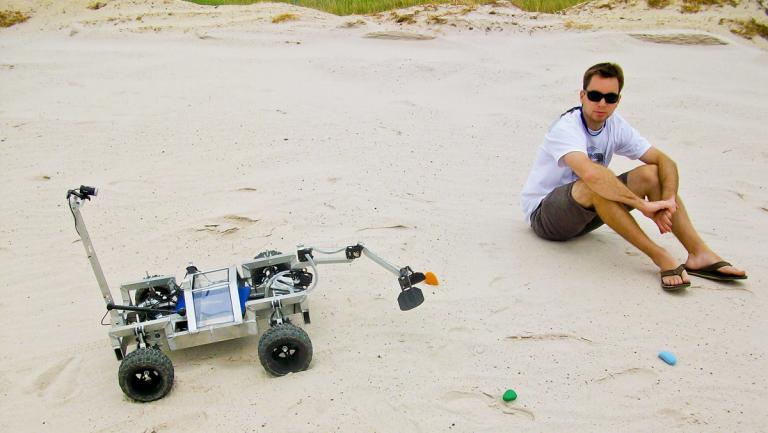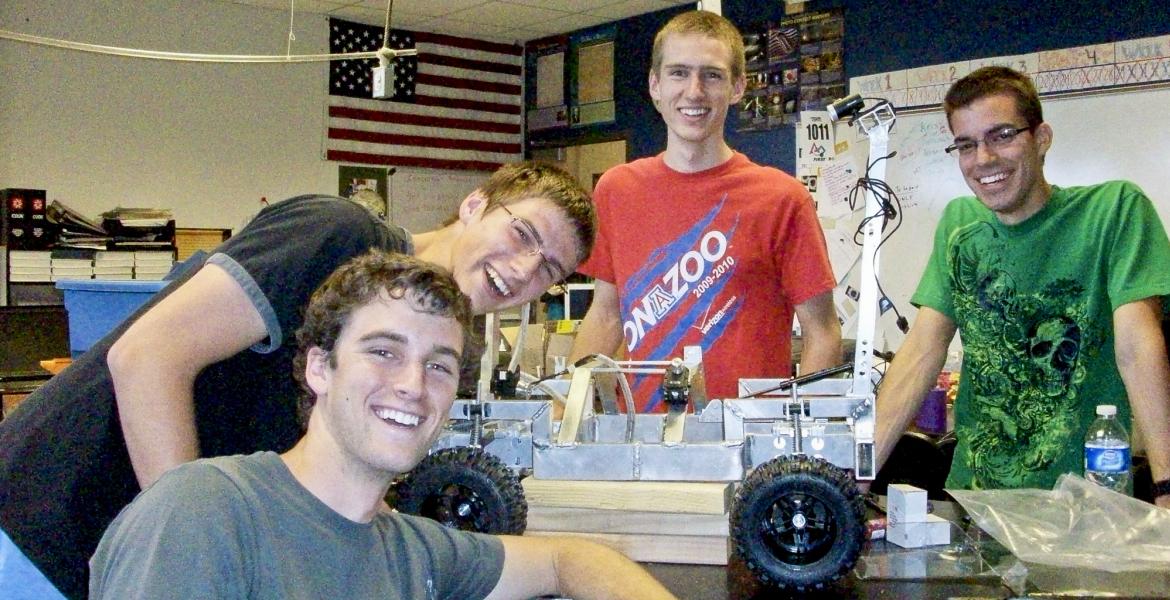UA Student Robotic Rover Team Among Best in Nation
UA Engineering students recently won $10,000 funding to compete in a new NASA robotics competition.
Only seven teams in the nation qualified for the National Institute of Aerospace award, which enabled them to design and build a planetary rover and demonstrate its capabilities at the NASA Johnson Space Center's Rock Yard in Houston in May 2011.
NASA's multi-acre Rock Yard, officially known as the Planetary Analog Test Site, simulates lunar and Martian landscapes and is used by NASA to test habitats, rovers, and spacesuits.
NASA and the National Institute of Aerospace established the new student rover competition, snappily titled "Revolutionary Aerospace Systems Concepts, Academic Linkage, Exploration Robo-Ops," aka Rascal, to test the robot-building skills of university students, and to spark interest in planetary rovers and robotics.
The competition required the rover to negotiate obstacles and traverse difficult terrain, and to identify and collect various colored rocks while being controlled via broadband from "mission control" at UA.
Teams also had to submit a technical paper to support their rover projects, and the UA team scored the highest among the seven finalists for its technical paper.
"This was our first time in a robotics competition," said Brandon Pitts, Rascal team member and aerospace engineering junior. "We were competing against teams that had master's and PhD students, so we were shocked when we got the highest score for our paper."

Out in the Rock Yard, gremlins got to the team's Exploratory Space Vehicle, or XSV, which had servo trouble. "We were not able to pick up any rocks, but gave a good show," said Rascal team leader Jordan Odle, also an aerospace engineering junior. "One of our servos on the arm shut off, which caused the arm to not operate."
"We ended up not placing but received the highest score for our technical paper," Odle said, undeterred. "Overall it was a great experience and we are thinking about competing again next year."
The UA Rascal team designed, funded, built, tested and completed the competition in 3 months!
"Construction started mid-February after we learned that we had received the funding from NASA, and we dedicated just about every weekend after that to machining and putting the rover together from scratch," Odle said. "This whole process has been an excellent learning experience."
Odle's ambitious schedule and strict timeline might have been influenced by his impending wedding day in May. In fact, he was on his honeymoon the week of the competition.
"Our deadline to complete the rover was Jordan's wedding," Pitts said. "When we got to the competition, the other teams were still tweaking their designs, but we were completely finished."
In hindsight, Pitts has a sneaking suspicion that being so ahead of the game might have worked against the UA team. "We had a lot of spare time at the competition, so we did a lot of testing," he said. "It's possible we overworked the servo, causing it to shut down during the competition."
But Pitts has this covered for the next generation of XSV design. "Future builds will probably include a remote reset, because you can't physically interfere with robots once they are in competition."
The XSV team said they could not have competed without the support of the Sonoran Science Academy in Tucson, Ariz. "They provided us with extensive use of their robotics lab throughout the fabrication phase of the project," said Odle. "They definitely have some of the best robotics programs and facilities for high school students, and participate in FIRST Robotics every year as team Crush 1011."
The Rascal team built the XSV from discount-priced aluminum remnants provided by Caid Industries, an engineering firm headquartered in Tucson. "Jordan and his younger brother, Jesse, both attended the Sonoran Science Academy and were involved in FIRST," Pitts said. "They taught us how to use the academy's mills and lathes."
FIRST is the acronym created by For Inspiration and Recognition of Science and Technology, a nonprofit created by inventor Dean Kamen to inspire young people to be science and technology leaders. FIRST attracts thousands of students from around the world to its annual robotics completion and awards about $15 million in scholarships.
In addition to building and demonstrating a rover, and submitting a written final report, all Rascal teams were required to conduct education and outreach via social media websites and other creative outlets. In addition to setting up a Facebook page, the XSV team held open houses at the Sonoran Science Academy, which were attended by students from the academy and from other schools. "It's cool showing kids this project and getting them interested in engineering," Pitts said.
The XSV team consisted of Jordan Odle, Aaron Petras and Brandon Pitts, all UA aerospace engineering juniors; Daniel Papajohn, a UA electrical and computer engineering freshman; plus Lane Ellwood, a Pima Community College student, and Jesse Odle, a Sonoran Science Academy senior, both of whom will enroll in aerospace and mechanical engineering at UA in the fall.
The team's faculty advisor at UA is Ara Arabyan, associate professor in aerospace and mechanical engineering and associate head of undergraduate studies. Jeremy Fergason, who oversees software development in the advanced technology division of Rincon Research Corporation, also advises the XSV team.
The seven finalists in this inaugural competition were University of Arizona, University of Buffalo, University of Maryland, University of Pennsylvania, University of Texas at Arlington, University of Utah, and Worcester Polytechnic Institute.


